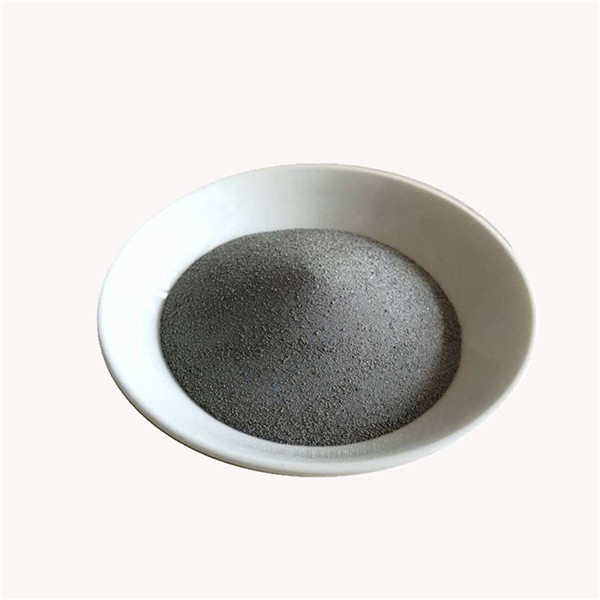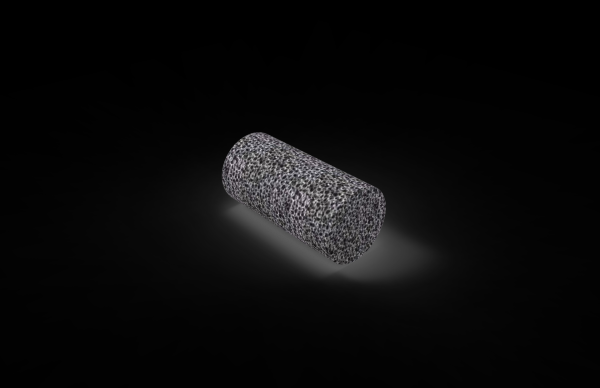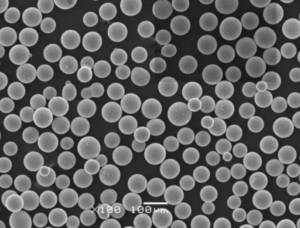はじめに
急速に発展する今日の産業界では、優れた特性を持つ素材が求められている。 ガスアトマイズ粉末 ガスアトマイズ粉末は、優れた特性と比類のない汎用性を提供する、画期的なソリューションとして登場した。この記事では、ガスアトマイズ粉末の魅力的な世界を探求し、その製造プロセス、利点、用途、将来の展望を理解する。
ガスアトマイズド・パウダーとは?
ガスアトマイズ粉末は、溶融金属または合金の霧化によって生成される細かく分割された粒子である。このプロセスでは、原料を溶かし、高速のガス流で微細な液滴に分散させます。これらの液滴は、降下中に急速に凝固して球状の粉末となり、均一で高度に制御された粒度分布が得られます。

ガスアトマイズ粉末はどのようにして製造されるのか?
ステップ1:原材料の選択
ガスアトマイズの最初の重要なステップは、原料の慎重な選択である。最終的な粉末の望ましい化学組成と特性は、この選択プロセスを導きます。
ステップ2:溶解プロセス
原材料が選択されると、純度と一貫性を維持するために制御された環境で溶解される。この目的のためには、誘導溶解または電気アーク溶解が一般的に採用されている。
ステップ3:噴霧化プロセス
その後、溶融金属はノズルに押し込まれ、そこで高速ガス流(通常はアルゴンまたは窒素)と接触する。ガスは、せん断力によって液体金属を小さな液滴に分解する。
ステップ4:回収と取り扱い
液滴が落下すると、急速冷却により球状の粒子に固化する。これらのガスアトマイズされた粉体は回収され、ふるい分けや包装などの後処理を受ける。
ガスアトマイズ粉末の利点
ガスアトマイズ粉体にはいくつかの利点があり、様々な産業で高い人気を誇っている:
高純度
ガスアトマイズプロセスによりコンタミネーションを最小限に抑え、高純度レベルのパウダーが得られるため、重要な用途に適している。
優れた粒度分布
ガスアトマイズ粉末は粒度分布が狭く、最終製品の一貫性と均質性の向上に寄与する。
流動性の向上
ガスアトマイズ粉末は球状であるため流動性に優れ、様々な用途でよりスムーズな加工が可能です。
真球度の向上
これらの粉末の球状形態は、充填密度の向上と気孔率の減少につながり、材料の全体的な性能を向上させる。
カスタマイズ性
ガスアトマイズは、粒子径、化学組成、形態を精密に制御することができ、特定のニーズに合わせたオーダーメイドの粉体を可能にする。

ガスアトマイズ粉末の用途
ガスアトマイズ粉末は、さまざまな最先端技術に幅広く応用されている:
アディティブ・マニュファクチャリング(3Dプリンティング)
ガスアトマイズ粉末は、選択的レーザー溶融(SLM)や電子ビーム溶融(EBM)などの金属積層造形プロセスにとって重要な原料であり、複雑で高性能な部品の製造を可能にする。
金属射出成形(MIM)
MIMでは、ガスアトマイズされた粉末をバインダーと混合し、射出成形に適した原料を作る。このプロセスは、卓越した機械的特性を持つ小型で複雑な部品を製造するために広く使用されています。
溶射コーティング
ガスアトマイズ粉末は溶射皮膜に使用され、基材の表面特性を向上させ、耐摩耗性、耐食性、断熱性を提供する。
粉末冶金
ガスアトマイズ粉末の多用途性は、粉末冶金工程に理想的であり、自動車、航空宇宙、医療用途の部品を製造するために粉末を圧縮・焼結する。
ろう付けとはんだ付け
組成を調整したガスアトマイズ粉末は、ろう付けやはんだ付けの用途に利用され、さまざまな金属アセンブリの強固で信頼性の高い接合を保証します。
ガスアトマイズ粉末と他の粉末製造法との比較
ガスアトマイズは、金属粉末を製造するために使用されるいくつかの技術の一つに過ぎません。他の一般的な粉体製造方法と比較してみましょう:
水の霧化
水アトマイズはガスアトマイズと同様のプロセスであるが、ガスの代わりに水をアトマイズ媒体として使用する。水アトマイズはエネルギー効率が高い反面、粉体中の酸素や水素の汚染レベルが高くなる可能性があるため、高純度用途にはガスアトマイズが適している。
プラズマ霧化
プラズマアトマイゼーションは、プラズマアークを使って原料を溶かし、溶けた金属をガスで霧状にする。この方法は、特殊な合金やユニークな特性を持つ材料を製造するためによく使われる。
機械的合金化
メカニカルアロイングは、粉末を混合して高エネルギーのボールミリングにかける固体粉末加工技術である。メカニカルアロイングはナノ構造の粉末を製造することができるが、ガスアトマイズの方が粒子径と組成の制御が容易である。

ガスアトマイズの品質管理
ガスアトマイズ粉末の品質を確保することは、その応用を成功させるために不可欠である。品質管理にはいくつかの要因があります:
ガスの選択と雰囲気制御
霧化ガスの選択とプロセス中の雰囲気の制御は、汚染を防ぎ、望ましい組成を維持する上で重要な役割を果たす。
粒度分析
正確な粒子径分析は、パウダーが仕様に適合しているかどうかを確認するために不可欠であり、さまざまな用途で一貫した性能を保証します。
化学成分分析
徹底した化学分析により、パウダーの組成を確認し、必要な規格と特性を満たしていることを検証する。
パウダーハンドリングとパッケージング
ガスアトマイズ粉末の適切な取り扱いと包装は、汚染を防ぎ、保管や輸送中の特性を維持するために非常に重要である。
ガスアトマイズの課題
ガスアトマイゼーションには多くの利点がある一方で、いくつかの課題もある:
気孔率と酸化
ガスアトマイズ粉末の急速な凝固は、時に気孔や表面酸化を引き起こし、材料の機械的特性に影響を及ぼすことがある。
粒子凝集
微粒化中に粒子が凝集し、粒度分布が不規則になることがある。凝集を最小限に抑えるためには、慎重なプロセス制御が必要である。
エネルギー消費
ガスアトマイズプロセスは、特に高融点合金を扱う場合、エネルギーを大量に消費する可能性がある。継続的な研究は、エネルギー効率の最適化を目指している。
ガスアトマイズ技術の将来動向
ガスアトマイゼーションは進化を続けており、エキサイティングな将来性を持っている:
ナノ構造粉末
ガスアトマイズ技術の進歩により、最先端用途向けに特性が向上したナノ構造粉末の製造が可能になる。
複合パウダー
研究者たちは、ガスアトマイズによって複合粉末を製造し、異なる材料を組み合わせて新しい多機能材料を作り出す可能性を探っている。
積層造形の進歩
アディティブ・マニュファクチャリングの成長は、ガスアトマイゼーションのさらなる技術革新を促し、より複雑で要求の厳しい用途向けにパウダーを調整する。

結論
ガスアトマイズ粉末は、材料科学や製造工程に革命をもたらし、現代産業において不可欠なものとなっています。高純度、制御された粒度分布、カスタマイズ可能性など、ガスアトマイズ粉末が持つユニークな利点は、幅広い用途に最適です。技術の進歩に伴い、ガスアトマイゼーションのさらなる目覚ましい発展が期待され、産業界全体で新素材や画期的な革新がもたらされるでしょう。
よくある質問
ガスアトマイズ粉末は金属用途にのみ使用されるのですか?ガスアトマイズ粉末は、その優れた特性により、主に金属用途に使用される。しかし、特殊な用途では非金属材料にも使用できます。
ガスアトマイズ中の粉体品質に影響を与える主な要因は何ですか?主な要因としては、ガスの選択、雰囲気制御、溶融プロセス・パラメーター、ふるい分けや包装などの後処理工程が挙げられる。
ガスアトマイズ粉末は医療用インプラントに使用できますか?そう、ガスアトマイズ粉末は、生体適合性と性能のために高純度と制御された特性が重要な医療用インプラントに一般的に使用されている。
ガスアトマイズ粉末の典型的な粒子径範囲は?ガスアトマイズ粉末の粒子径は、一般的に数マイクロメートルから数百マイクロメートルの間であり、特定のアプリケーションの要件によって異なる。
ガスアトマイズは、他の粉体製造方法と比べてコスト面でどうですか?ガスアトマイゼーションの費用対効果は、特定の用途と製造される材料に依存する。場合によっては、ガスアトマイゼーションは、他の方法と比較して、より効率的で費用対効果の高い解決策を提供することもあれば、別の技術が好まれることもある。
Frequently Asked Questions (Supplemental)
1) What gases are most commonly used for producing Gas Atomized Powders and why?
- Argon is favored for inertness and low reactivity; nitrogen is used for cost efficiency and for steels where nitride formation is acceptable. Specialty mixes or helium additions can improve heat transfer and reduce particle satellites.
2) How does nozzle design affect Gas Atomized Powders quality?
- Close‑coupled nozzles and optimized gas‑to‑metal ratio (GMR) improve sphericity, narrow the particle size distribution (PSD), and reduce satellites. Poor atomization leads to wider PSDs, irregular particles, and inferior flowability.
3) What typical PSD should I choose for LPBF vs. DED vs. MIM?
- LPBF/SLM: ~15–45 μm; DED: ~45–150 μm; MIM: typically <22 μm with tight fines control. Select PSD to balance flow, packing density, and process stability.
4) Can Gas Atomized Powders be reused in additive manufacturing?
- Yes, with controls: sieve to remove spatter/satellites, blend back with virgin powder, and track oxygen/nitrogen/hydrogen, PSD, apparent density, and flow. Set reuse limits based on statistical property drift and defect analytics.
5) Are Gas Atomized Powders suitable for reactive alloys like titanium and aluminum?
- Yes, provided high‑purity feedstock, ultra‑clean melting, inert gas atomization, and stringent oxygen/moisture control are used. Powder passports should specify interstitials (O/N/H) and inclusion content for qualification.
2025 Industry Trends and Data
- Traceable supply chains: Digital powder passports capturing chemistry, PSD, O/N/H, inclusion rating, reuse count, and EHS data are becoming standard in RFQs.
- Energy efficiency: Argon recirculation, heat recovery from melt/atomization towers, and AI‑assisted process control cut energy per kg by 10–20% vs. 2023.
- Quality by design: In‑line laser diffraction and high‑speed imaging at the tower improve batch‑to‑batch PSD consistency for Gas Atomized Powders.
- Sustainability metrics: Producers report EPDs with recycled content disclosure; more alloys offered with 20–40% certified recycled feedstock.
- Application growth: Binder jetting and LPBF adoption expand for stainless, tool steels, Ni‑ and Co‑base alloys; aluminum and titanium volumes grow with green/blue lasers and improved powder cleanliness.
| KPI (Gas Atomized Powders), 2025 | 2023 Baseline | 2025 Typical/Target | Why it matters | Sources/Notes |
|---|---|---|---|---|
| PSD consistency (D50 batch‑to‑batch CV) | 6–8% | 3–5% | Process stability | Producer QC data |
| Satellite content (≥5 μm per 100 particles) | 4–6 | 2–3 | Flowability/defect reduction | SEM image analysis |
| Oxygen for AM‑grade Ti powders (wt%) | 0.15–0.20 | 0.10–0.15 | Ductility/fatigue | Powder passports |
| Apparent density variation across lots | ±6–8% | ±3–5% | Layer packing | ISO/ASTM 52907 tests |
| Qualified reuse cycles (LPBF steels) | 4–6 | 6–10 | Cost/sustainability | Plant case studies |
| Argon consumption per kg powder | Baseline | −10–20% | OPEX/CO2e | OEM/producer disclosures |
| Recycled content in ferrous powders | 10–20% | 20–40% | ESG/Cost | EPD/LCA reports |
Authoritative resources:
- ISO/ASTM 52907 (metal powder characterization) and 52904 (LPBF practice): https://www.iso.org
- ASTM B214/B822 (sieve and laser PSD), B212/B213 (apparent density/flow), F3302 (AM process control): https://www.astm.org
- ASM Handbook, Powder Metallurgy and Additive Manufacturing: https://dl.asminternational.org
- NIST AM Bench datasets: https://www.nist.gov/ambench
- Responsible Minerals Initiative (RMAP): https://www.responsiblemineralsinitiative.org
Latest Research Cases
Case Study 1: AI‑Assisted Argon Recirculation Cuts Cost and Satellites in Stainless 316L Powder (2025)
- Background: A powder producer sought to reduce argon usage and improve sphericity for LPBF customers.
- Solution: Implemented closed‑loop argon recirculation with moisture/O2 scrubbing; added in‑tower high‑speed imaging and ML models to tune gas‑to‑metal ratio and nozzle pressure in real time.
- Results: Argon consumption −18%; satellite count −35%; PSD D50 CV dropped from 7.1% to 4.2%; LPBF customer reported 0.3% increase in as‑built density and improved layer spreadability.
Case Study 2: Gas Atomized Ti‑6Al‑4V with Ultra‑Low Oxygen for Lattice Implants (2024)
- Background: A medical AM firm needed improved ductility/fatigue in lattice cups.
- Solution: Adopted high‑purity feedstock, ultra‑dry argon atomization, and rapid post‑atomization vacuum heat treatment; enforced powder passports with O ≤0.12 wt%.
- Results: Powder O reduced from 0.17% to 0.11%; HIPed LPBF parts showed elongation +12% and HCF endurance limit +9% vs. prior lot; first‑pass yield +7%.
Expert Opinions
- Prof. Randall M. German, Powder Metallurgy Scholar and Author
- Viewpoint: “Consistent PSD and low surface oxides from gas atomization translate directly to predictable densification and mechanical properties in downstream AM and MIM.”
- Dr. John J. Dunkley, Atomization Specialist
- Viewpoint: “Optimized gas‑to‑metal ratios and close‑coupled nozzles are the fastest levers to reduce satellites and improve flowability without major capital changes.”
- Dr. Martina Zimmermann, Head of Additive Materials, Fraunhofer IWM
- Viewpoint: “Digital traceability—powder passports tied to in‑situ monitoring—has moved from nice‑to‑have to required for regulated applications.”
Affiliation links:
- ASM International: https://www.asminternational.org
- Fraunhofer IWM: https://www.iwm.fraunhofer.de
- MPIF/ASTM AM CoE: https://amcoe.org
Practical Tools/Resources
- Standards and test methods: ISO/ASTM 52907, ASTM B214/B822 (PSD), B212/B213 (density/flow), F3302 (AM process control)
- Metrology: Laser diffraction PSD analyzers; Hall/Carney flowmeters; LECO O/N/H analyzers (https://www.leco.com); SEM imaging for morphology
- Process simulation and control: CFD for atomization towers; ML toolkits for gas‑to‑metal ratio optimization; Ansys Additive for downstream process planning
- Databases: Senvol Database (https://senvol.com/database); MatWeb (https://www.matweb.com); NIST AM Bench datasets
- ESG/traceability: Powder passports, EPD templates, and RMI/RMAP guidance for responsible sourcing
Last updated: 2025-08-22
Changelog: Added 5 supplemental FAQs; provided 2025 trends with KPI table and references; included two case studies on argon recirculation/AI control and ultra‑low‑oxygen Ti powders; added expert viewpoints with affiliations; compiled standards, metrology, simulation, and ESG resources for Gas Atomized Powders.
Next review date & triggers: 2026-02-01 or earlier if ISO/ASTM standards update, major OEMs mandate expanded powder passports, or new datasets on satellite reduction/energy efficiency in gas atomization are published.

